Chapter 13
Detailed Presentation of the Conceptual Vocabulary [Object of analysis]
13.1. Introduction
This chapter is given over to a more detailed presentation of certain parts of the vocabulary of conceptual terms denoting the objects of analysis in the ASW universe of discourse.
Section 13.2 is devoted to a general presentation of the branch [Object “Endurant”], which is divided into two more specialized branches – [Natural object] and [Object of value].
In section 13.3, we shall once again come back to the organization of the metalexicon. We shall more particularly discuss the notion of the taxonomic domain which we use to classify the conceptual terms and structure into small, semantically homogeneous groups.
In section 13.4, we shall again discuss the question – a tricky one for any attempt to set up a unique descriptive framework – of how to give an account of different classifications (scientific, “popular”, practical, etc.) of a domain of knowledge, using the meta-lexicon of conceptual terms.
The remaining sections – 13.5 to 13.11 –are dedicated to a more in-depth presentation of the different branches which make up the meta-lexicon of conceptual terms representing analytical objects in the ASW universe of discourse.
13.2. The two branches [Natural object] and [Object of value]
The branch of the ASW vocabulary of conceptual terms which is based on the conceptual term [Object “Endurant”] (see Figure 12.2 in section 12.5), refers to the set of objects, systems or collections of objects from the “natural” or social world. To borrow a distinction from Searle [SEA 95], it refers, on the one hand, to objects and events with intrinsic features and, on the other, to objects which only possess their features in reference to a observer, which, as Greimas said a long time ago [GRE 76; GRE 79], are objects of value (relative to a subject).
Thus, for instance, diamond possesses “natural” features which are “intrinsic”to it and which are independent of human beings. These features include, for example, the fact that it is made of carbon, possesses a certain crystalline structure, has specific physical properties, etc. However, the fact that diamond is a highly soughtafter object in industry and in jewelry (thus, the fact that it is an object of value), for which people do not hesitate to part with enormous sums of money, and are sometimes prepared to accept the very worst humanitarian compromises to obtain, is obviously not an intrinsic property of the mineral. The fact of being highly sought after (because it is very rare and “therefore” socially distinctive, beautiful, precious, useful, indispensable, etc.) qualifies diamond as a physical object with a particular status in reference to this industry or that social group.1
In order to reflect this distinction, the branch [Object “Endurant”] is divided into two main sub-branches: the sub-branch which begins with the conceptual term [Natural object] and the sub-branch which begins with the conceptual term [Object of value].
As Figure 13.1 shows, the branch of conceptual terms based on the term [Natural object] is constructed around two main taxa the taxon [Non-living object] and the taxon [Living object]. The former contains conceptual terms for describing topics referring to the world of inanimate object and systems thereof, including particularly (in our case), those referring to the main natural elements of everyday life, such as minerals, metals, sediments but also water, fire, air or earth. The latter contains conceptual terms for describing topics thematizing such-and-such a species of flora or fauna, such-and-such a physiological organ, such-and-such an ecosystem, etc.
Figure 13.1. Extract of the branch [Enduring Object] with the taxa organizing the sub-branches [Natural object] and [Object of value]
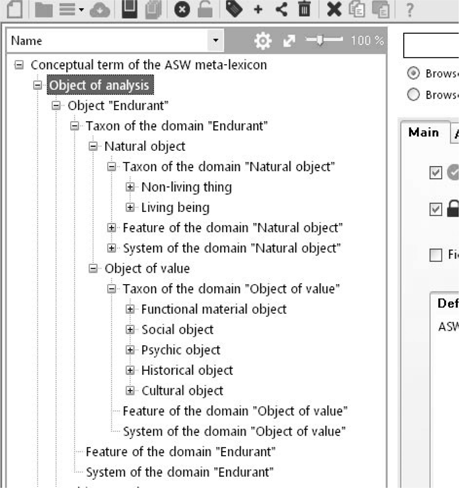
Let us now take a look at the branch of the ASW meta-lexicon which begins with the term [Object of value]. As shown in Figure 13.1, the taxonomic level of the term [Object of value] is not entirely expanded in the current version of the ASW metalexicon. Like any taxonomical domain of knowledge (whatever the level of generality or specialization) belonging to the ASW universe of discourse*, we anticipate a need for two other conceptual terms – [Feature of the domain of value] and [System of objects of value]2 – besides the conceptual term [Taxon of the domain of value]. These two additional conceptual terms can be used for very general and only very slightly differentiated descriptions, which cannot or do not wish to draw distinctions, for example, between social, historical and cultural domains.
The branch in question, in its current version, contains five major taxonomic domains of knowledge.3 The first taxonomic domain of knowledge is represented by the conceptual term [Functional material object] and covers, among other things, what we call the tangible culture (of a social group, a civilization, etc.). This taxon includes all the conceptual terms which serve to give an account of the physical objects defined in relation to a subject (an observer, a user, a professional, etc.). For instance, these could be objects such as constructions, products and tools but also creations and expressions (verbal, musical, etc.) or indeed which have a specific cultural status (such as monuments, memory objects, objects such as relics or fossils which constitute physical traces of a past).
The second taxonomic domain of knowledge is represented by the conceptual term [Social object]. Under this taxon, we find the set of conceptual terms which serve for describing topics thematizing aspects of the social world: social life, actors, social regimes and systems, etc.
The third taxonomic domain of knowledge is represented by the conceptual term [Psychic object]. This taxon – which has been very underdeveloped hitherto – includes the terms which are needed to describe the domains of knowledge thematized in an (audiovisual) text or corpus relating to behaviors, attitudes, cognitive capabilities, etc.
The fourth taxonomic domain of knowledge is represented by the conceptual term [Historical object]. This taxon identifies the conceptual terms which serve to describe subjects which speak about the past or a particular era, civilization, type of history (history of a country, history of a sector of activity, history of a social group, history of a scientific discipline, etc.).
The fifth taxonomic domain of knowledge is represented by the conceptual term [Cultural object]. Under this final taxon we class the conceptual terms which enable us to describe topics which refer to symbolic objects (lato sensu). These are languages lato sensu (including natural languages) and cultures in the sense of cognitive models and reference frameworks. As we shall see later on, here we distinguish between epistemological cultures (including scientific culture), axiological cultures (including legal culture), deliberative cultures (including political culture), and artistic cultures (in the sense, here, of “technical savoir-faire; techne”) for example.
The five taxonomic domains in question are constructed in a manner identical to the taxonomic domains referring to the natural world. However, some of them are presented in a more elaborate way than others. Given the context of our research, it is notably the domains represented by the conceptual terms [Cultural object], [Social object] and [Functional material object] that we have been able to elaborate further, test and validate in the form of concrete analyses of audiovisual corpora.
Before briefly presenting a small section of taxonomic domains of knowledge, let us take a look at a few general questions relating to the terminology and organization of the ASW vocabulary of conceptual terms – questions which are equally valid for the vocabulary of conceptual terms representing the procedures of analysis (Chapter14) as well as for libraries of schemas of definition and sequences of description (Chapter16).
13.3. Questions of organization of the ASW meta-lexicon
When carrying out the task of definition and classification per se, we had to take account of two complementary aspects:
– classification of the conceptual terms according to the taxonomic logic from the most general to the most specific;
– recourse to semantic dimensions (or classemes, to use the terminology of Greimas’ structural semantics [GRE 67]), which motivate and explicitize the taxonomic classification of a set of terms under the “umbrella” or “heading” of a more general term.
Let us first remind ourselves that the expression conceptual term* means the (standardized, controlled) expression of a concept (a notion or theme*). In the ASW meta-lexicon, a conceptual term can be identified as follows:
– a conceptual term occupies a position of its own in the taxonomic hierarchy of all the conceptual terms which make up the meta-lexicon;
– a conceptual term is part of one of the three elements in the canonic triplet which organizes a taxonomic domain of knowledge (see below);
– a conceptual term is differentiated from the other conceptual terms of the same hierarchical level (and which also belong to one of the elements of the canonic triplet) in reference to at least one classeme.
A canon (or canonic base) of conceptual terms is a set of terms which form the basis of the ASW meta-lexicon itself, or indeed of such-and-such a taxonomic domain of knowledge. Thus, in principle, any taxonomic domain of knowledge will include the following triplet of conceptual terms:
1. [Taxon]: a canonic conceptual term which enables us to express the point of view according to which the objects in the taxonomic domain are identified and classified;
2. [Feature]: a canonic conceptual term which enables us to identify objects in a given taxonomic domain whose existence depends on a “supporting object”. Typically, such objects are qualities, quantities, attributes, roles, statuses, and so on.
3. [System]: a canonic conceptual term which enables us to identify objects in a given taxonomic domain which form or are apprehended in the form of organized systems, whole sets or simple assemblies, etc.
This triplet includes two major classemes, two semantic dimensions [RAS 87] which, in principle, are to be found at every level of the ASW meta-lexicon of conceptual terms:
– the first dimension draws the distinction between independent objects and dependent objects (i.e. objects which depend upon a “support object” for their existence);
– the second dimension distinguishes between objects taken as a whole and, on the other hand, entities which form or are perceived as plural entities – structured or otherwise, compound or massive, etc. (see Brøndal & Greimas [BRO 86], who draw the distinction between totus and omnis).
Every level of specialization of the branch [Object of analysis] in the ASW metalexicon allows for this double semantic distinction even if it is not systematically realized in the current version of that branch. For instance, Figure 13.1 shows that the taxonomic domain of knowledge initiated by the conceptual term [Object of value] does not use the full extent of its canonic base. The reason for this is purely practical: we did not need so general a taxonomic domain for analyzing our audiovisual corpora.
As has already been said, a conceptual term belongs to one or other of the three canonic terms which form the structure of a taxonomic domain of knowledge. Thus, in the current version of the ASW meta-lexicon, a conceptual term denotes:
– either an object classified according to a certain point of view, taken from the taxonomic domain in question;
– or a element (a quality, attribute, trait, specific part, etc.) which is a feature of the taxonomic domain;
– or indeed a system, a totality, a mass or simply a collection (non-structured, random, etc.) of objects from the taxonomic domain.
Let us now consider the expression taxonomic domain of knowledge. It is a conceptual field (of conceptual terms) which possesses a certain semantic homogeneity thanks to the conceptual term which serves as the closest heading to the branch in which it (the conceptual field in question) lies. For instance, the term [Natural object] is the closest heading to the taxonomic domain (of a very general level in the context of the ASW meta-lexicon) whose canonic base is the triplet [Taxon of the domain “Natural object”], [Feature of the domain “Natural object”], [System of the domain “Natural object”].
The most general taxonomic domain of knowledge objects in the ASW universe of discourse is that whose heading is the conceptual term [Object of analysis]. In the current manifestation of the ASW meta-lexicon, it is not deployed to its full extent, but if need be, it is easy to do so. In any case, the ASW meta-lexicon forms a hierarchy of taxonomic domains of knowledge, from the most general to the most circumscribed.
As already pointed out in Chapter12, the current version of the meta-lexicon of conceptual terms denoting analytical objects in the ASW universe of discourse* distinguishes some 85 taxonomic domains of knowledge. These form the common part of the meta-lexicon, i.e. shared by all models of description elaborated with a view to analyzing the most diverse of audiovisual corpora. This shared part can only be modified by the responsible part (the administrator or piloting committee) of the ASW meta-lexicon. On the other hand, each taxonomic domain of knowledge can be complemented by new conceptual terms and/or new taxonomic domains of knowledge. These additions form the part which is modifiable, and peculiar to the concept designer (the knowledge engineer) of the particular archive.
In concrete terms, if an anthropologist working on the intangible cultural heritage of a people or region develops his own models of description (i.e. his own library of models of description), he:
– relies (amongst other things) on the meta-lexicon of conceptual terms denoting the analytical objects in the ASW universe of discourse and identifies those he needs in order to define the topical structure(s)* relating to the universe of discourse of an audiovisual archive;
– if, in an existing taxonomic domain of knowledge, a conceptual term does not appear, the researcher adds it in the form of a conceptual term specific to a group of users;
– if a taxonomic domain of knowledge is missing from the ASW meta-lexicon, the researcher adds it as a new object of analysis* (that is, [Object …]) peculiar to “his” group of users – an object of analysis which is employed in the form of the canonic triplet [Taxon of the domain …], [Feature of the domain…], [System of the domain …].
Let us again highlight that there must be no confusion between the taxonomic domain of knowledge and the topical structure* (or indeed, a fortiori, the thematic structure*; see section 5.3) defining a domain of knowledge which can be thematized (in one way or another) in an audiovisual text or corpus. The former, as we have just seen, is a field made up of conceptual terms which has a certain semantic homogeneity thanks to the conceptual term which serves as the closest heading to the branch in which that conceptual field lies. The latter is an arrangement which models a domain of knowledge, and in doing so, selects the conceptual terms relevant to it – no matter whether they come from one or several taxonomic domains in the ASW meta-lexicon. As we have already seen many times in the preceding chapters, the conceptual terms selected in a topical configuration* often come from different taxonomic domains and maintain relations other than simply hierarchical ones in the taxonomical sense of the term.
Let us return once again to the organization of the ASW vocabulary of conceptual terms. This is essentially based on the relations of unilateral dependency and reciprocal dependency between conceptual terms belonging to the vocabulary. The former manifests itself in the positioning of general and specialized conceptual terms in relation to one another (or between conceptual terms which have a variable semantic density). Here we speak of hypernyms and hyponyms (the hypernym is the more general conceptual term, the hyponym the more specific conceptual term). The latter relates to the positioning of two or more conceptual terms which all depend on the same hypernym conceptual term and which are therefore partially similar (or, if we wish, dissimilar). This second relation enables a distinction to be drawn between antonymous conceptual terms or contrary ones (in the sense of gradual opposition; this should be distinguished from contradiction which is an opposition of mutual exclusion).
Finally, as stated above, in addition to the two basic relations for constructing any hierarchical vocabulary of conceptual terms (namely that of hypernymic/ hyponymous specialization and that of gradual opposition or mutual exclusion), we also use a set of other semantic categories called classemes in structural semantics [GRE 66], to identify and distinguish groups or semantic subsets of conceptual terms from the set of terms which make up the ASW meta-lexicon. One particular category of these classemes is made up of those which F. Rastier calls semantic dimension [RAS 87] – a type of category which forms a small delimited class of (gradual) oppositions.
Without wishing to enter into too complex a discussion here (which would touch on the issue of the status of classemes and a theory of classemes), let us simply mention a few of these semantic dimensions which play a part in the organization of the ASW meta-lexicon of conceptual terms.
We have already introduced and discussed the two semantic dimensions which are truly crucial for the organization of our meta-lexicon. These are the semantic dimension of the existential dependency/independence of the objects and the distinction between plural and singular objects (“singular” in the sense of “unitary”). Of the other semantic dimensions which play a more or less significant role in the identification (or circumscription) of subsets of conceptual terms, the following three are particularly noteworthy:
– the dimension of the physical support according to which the analytical objects are distinguished from one another. Thus, we identify a subset of conceptual terms which denote somatic actions or mental actions (objects of analysis denoted by conceptual terms belonging to the branch [Object “Perdurant”]), material objects, social objects or mental objects (analytical objects denoted by conceptual terms belonging to the branch [Object “Endurant”]) or indeed geometric spaces, geographic spaces or represented spaces (analytical objects denoted by conceptual terms belonging to the [Object “Region”]). Another subset of conceptual terms is reserved for denoting objects which differ in terms of their perceptive specificity. Thus, for instance, we can identify and distinguish between gestural actions and visual actions (objects of analysis denoted by conceptual terms belonging to the branch [Object “Perdurant”]), and between visual objects and acoustic objects (objects of analysis denoted by conceptual terms belonging to the branch [Object “Endurant”]);
– the dimension of the function which the analytical objects may fulfill. With this semantic dimension, we identify conceptual terms which refer to analytical objects with a specific role to play in a given domain of analysis. Thus we identify conceptual terms which refer to the activities of extraction, production and construction, to the activities of transformation and communication or indeed to the activities of consumption (objects of analysis denoted by conceptual terms belonging to the branch [Object “Perdurant”]). We can also identify and denote objects of value which hold a specific status for an actor (memory objects, for instance, or also lucky charms) and objects which serve an actor and which constitute resources, tools, instruments, etc. for him (analytical objects denoted by conceptual terms belonging to the branch [Object “Endurant”]);
Figure 13.2. Extract from the branch of the ASW meta-lexicon representing the taxonomic domain [Epistemic culture]

– the modal dimension (after Greimas [GRE 83]) of the objects of analysis (including, notably, objects of value). This dimension brings together a subset of conceptual terms which refer to analytical objects that possess a specific epistemic status (e.g. fictional objects and spaces, imaginary eras, etc.). It also enables us to set apart a subset of conceptual terms, in the ASW meta-lexicon, which refer to activities, entities or regions with a definite moral (or ethical) status. Other subsets of terms which can be identified thanks to this semantic dimension are reserved for denoting activities or entities which have an aesthetic status, a deontic status or, finally, a phoric status (affective, emotional).
13.4. How are we to take account of different classifications?
Let us turn once again to our presentation of the two general taxonomic domains [Living being] and [Non-living object]. As we well know, there are very diverse classifications of the elements and entities which populate the inanimate or living world.
Certain classifications refer to scientific standards, others to secular practical knowledge, to popular belief or to practical and utilitarian objectives. It is not easy to take account of these different points of view, but in principle, it is possible in the context of the ASW vocabulary of conceptual terms. Thus, the very appellation, the principles and objectives of a specific classification system can be dealt with, using the taxonomic domain [Epistemic culture] of the ASW meta-lexicon – a taxonomic domain which belongs to the branch [Object of value].
Figure 13.3. Extract from the branch of the ASW meta-lexicon representing the taxonomic domain [Living being]
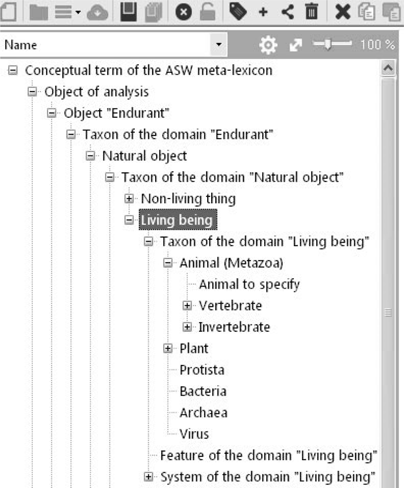
As Figure 13.3 shows, the taxon of this domain enables the analyst, according to his own opinion, to categorize a classification (of flora, fauna or the non-living world) as a scientific classification (based on biological or geological research, depending on the case), a classification which uses the doxa (tacit or traditional knowledge, etc.) of a particular group, or a practical or utilitarian classification which uses a technical culture. However, the taxonomic domain [Living being] must be used in order to describe the (living) elements classified into type by this-or-that classification (be it scientific, popular or otherwise).
Figure 13.4. Extract from the branch of the ASW meta-lexicon representing the taxonomic domain [Object animal species]
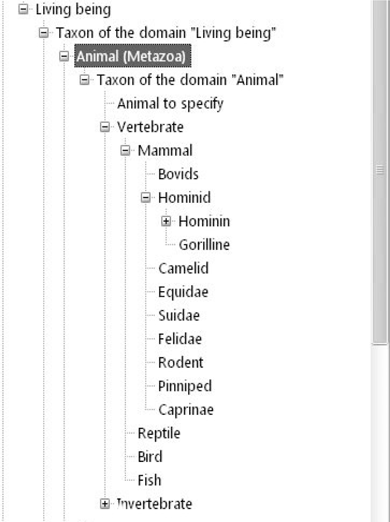
Figure 13.4 shows a more detailed extract from the taxonomic domain [Living being] which includes, among other things, the branch [Animal]. The choice and organization of the conceptual terms which populate the branch [Animal] show that we have followed a fairly standard classification of the animal kingdom. Yet still, neither the conceptual terms chosen nor their organization will necessarily satisfy the referential specificity of such-and-such a classification.
In its current state, the branch [Animal] cannot satisfy the exacting requirements of a description of topics which thematize, for example, the cladistic classification of the living world. Nor will it be able to satisfy the systematic and detailed description of such-and-such an ethno-classification of flora or fauna. There are two possibilities available to us in order to remedy this problem.
The first is to create a new taxonomic domain of knowledge within the branch [Living being] (see Figure 13.3) which corresponds to the requirements of a certain type of classification. This new conceptual domain may either belong to the shared vocabulary of the ASW meta-lexicon, or constitute a module peculiar to a user or group of users (see our explanations above, section 13.3).
Such a module could first be declared as an ontological addition to the ASW meta-lexicon, necessary in order to cover the universe of discourse of archives belonging to a particular community to a satisfactory degree. Then, the module could be assigned a specific place in the general economy of the ASW meta-lexicon. In our example, it would be a direct “descendant” of the basic conceptual term, [Living being].
A second option which we have developed further in our research is that of using micro-thesauruses to satisfy the various needs to identify, describe and classify natural or social facts. We have briefly discussed an example of the use of two different micro-thesauruses to describe and classify cultural facts: one of the two micro-thesauruses is a simplified version of UNESCO’s thesaurus relating to the domain of culture4; the other was developed during the ASW-HSS project. Of course, there is nothing to stop other micro-thesauruses from being added.
13.5. The conceptual domain represented by the term [Functional material object]
Figure 13.5 shows that the conceptual term [Functional material object] is one of the taxa which specify the conceptual term [Object of value]. Its taxonomic domain is made up of the canonic triplet [Taxon of the domain “Functional material object”], [Feature of the domain “Functional material object”] and [System of the domain “Functional material object”].
The taxonomic domain represented by this triplet of conceptual terms is the most general of the branch [Functional material object]: the features identified at this level (by way of the conceptual term [Feature of the domain “Functional material object”]) and the systems or sets (by way of the conceptual term [System of the domain “Functional material object”] are thus invariant or non-specific to a particular more specialized taxonomic domain and whose general organization is shown in Figure 13.6. Thus, at the level of the taxonomic domain of knowledge [Functional material object] (Figure 13.5), we find conceptual terms such as [Function] (of such-and-such a material object), [Status] (of such-and-such a material object), [Degree of technicality] (of such-and-such a material object), etc. At the level of the [Functional material system], we find such conceptual terms as, for example, [Material culture] and [Tangible heritage] which facilitate general and non-specific description of systems or sets of material objects relating to such-andsuch a social group, community, era, civilization and so on.
Figure 13.5. The conceptual domain [Functional material object]
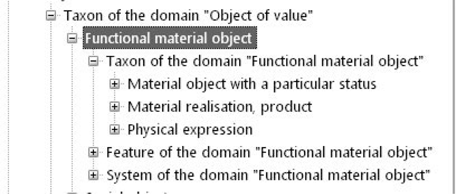
As Figure 13.5 shows, the branch beginning with the conceptual term [Functional material object] is broken up into three more specialized taxonomic domains which we have developed in reference both to our working corpus and to a whole series of specialized thesauruses5:
Figure 13.6. The subdivision of the branch [Functional material object] into more specialized taxonomic domains of knowledge

– the taxonomic domain of material objects – living or otherwise – which occupy a particular position in the lifeworld of an actor (see Figure 13.5, the branch beginning with the term [Material object with a particular status]). It is as much a question of physical persons and populations (human or otherwise) as of animals (pets, working animals, etc.) or all sorts of objects and collections of objects documenting a past or enabling that past to be reconstructed. The conceptual vocabulary making up that specialized branch thus brings together all the conceptual terms which enable us to analyze material objects (or sets of objects) that have a value for archaeology, prehistory or paleontology. In addition we find there all the conceptual terms which refer to physical objects with specific cultural value (historical, memorial, etc.), notably including monuments and documents in the sense of a material piece of information, historical or otherwise in nature;
Figure 13.7. The taxonomic domain of artifacts represented by the conceptual term [Creation/product]
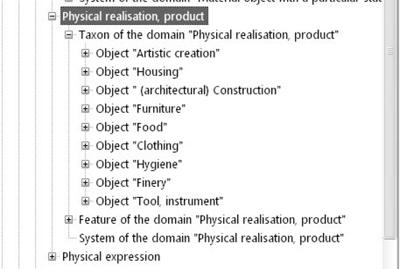
– the taxonomic domain of artifacts, i.e. creations and products such as works of art, buildings and dwellings, food, clothes, etc. This domain begins with the conceptual term [Physical creation, product]. Given its importance in the analysis of audiovisual corpora which deal with objects that form part of daily practices (living, eating, dressing, healing, introducing, etc.), this domain is completely deployed using a canonic triplet: [Taxon of the domain “Physical creation, product”], [Feature of the domain “Physical creation, product”] and finally [System of the domain “Physical creation, product”]. The taxonomic domain in question is broken down into more specialized, more circumscribed taxonomic domains, such as food, housing, clothing or construction (see Figure 13.7). In turn, each of these specialized taxonomic domains can, if necessary and useful, be broken down into even more specialized taxonomic domains. Thus, it is entirely possible to endow the ASW meta-lexicon with fine conceptual distinctions in the form of more specialized conceptual terms, operated e.g. by highly specialized thesauruses such as that of the designations of architectural and building works from the Direction de l’Architecture et du Patrimoine from the French Ministry for Culture and Communication6; and finally,
– the taxonomic domain of physical expressions – verbal or written expressions, musical expressions, audiovisual expressions, mimic and gestural expressions, etc. (see Figure 13.6). This domain, which begins with the conceptual term [Physical expression], plays a significant role in the description and classification of audiovisual corpora documenting, for example, verbal exchanges, musical creations, sound environment or indeed actions and programs of action.
13.6. The conceptual domain represented by the term [Social object]
Now let us consider the branch of the ASW meta-lexicon which begins with the conceptual term [Social object]. This covers all the vocabulary of conceptual terms which we use to describe social endurants, i.e. – grosso modo – entities, objects and sets of objects from the social world.
The vocabulary of conceptual terms of this branch, as it currently stands, enables us to describe and analyze themes or topics dealing with moral persons, all sorts of institutions, peoples, social groups, social movements, ways of life, social regimes, etc.
Figure 13.8 shows the organization of the complex taxonomic domain made up of a whole variety of more specialized domains. At the basic taxonomic level of the domain in question, we find our usual canonic triplet [Taxon of the domain “Social object”] (which breaks the domain down into a series of more specialized domains), [Feature of the domain “Social object”] and [System of the domain “Social object”]. This latter conceptual term is particularly useful in that it facilitates the description of topics in which it is a question, for example, of general (and usually rather vacuous) social facts such as the industrial society, the information society, the pre-capitalist society, etc. – subjects which, nowadays, are fairly popular and recurrent in human and social sciences.
In the current version of the ASW meta-lexicon, the conceptual term [Taxon of the domain “Social object”] (Figure 13.8) is broken down into four main taxonomic domains. The first conceptual domain is organized around the term [Social life]. This enables us to take account of topics dealing with questions which relate, for example, to rural or urban life, to economic and political life, to personal and private life, etc.
Figure 13.8. The taxonomic domain of objects of the social world represented by the conceptual term [Social object]
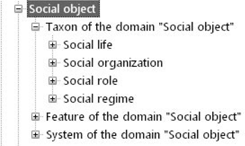
The second taxonomic domain, represented by the term [Social organization] (Figure 13.9) covers first the different types of social groupings (such as social group, social movement, people (and ethnicity), nation, community (ethnic, religious, linguistic, etc.), clan or family. It also covers various types of institutionalized organizations: institutions which run life in the different sectors of activities of an actor (of a social group); “traditional”, communitarian and modern institutions; institutions which exert their influence on a delimited territory; institutions endowed with power (decision-making power, coercive power, influence, etc.). Finally, a third type of analytical object is identified by the conceptual term [(political) State] which refers to the various forms of political organization of social life.
Figure 13.9. The taxonomic domain of objects of the social world represented by the conceptual term [Form of social organization]

The third taxonomic domain, which depends directly on the conceptual term [Taxon of the domain “Social object”], is represented by the term [Social role] (Figure 13.10). This conceptual term includes all the terms which enable us to analyze subjects or topics which deal primarily with roles defined by their belonging to a particular practice or profession.
It also includes the conceptual vocabulary needed to analyze general social roles, a category which includes the coherence, organization and self-comprehension of a social group in its entirety.
Figure 13.10. The taxonomic domain of objects in the social world represented by the conceptual term [Social role]

This is the case when we speak of a personality, an authority, a stranger, a leader or indeed a victim, an exile, etc. for example. A third knowledge object – not very well developed in the current incarnation of the ASW meta-lexicon – is that of the social roles related to sex, which is sometimes spoken of as “gender”.
Finally, the fourth taxonomic domain, which depends on the term [Taxon of the domain “Social object”] (Figure 13.8), is represented by the conceptual term [Social regime]. Under this term, we include the vocabulary we need to describe audiovisual texts which deal – either in isolation or in relation with other subjects – with questions relating to political, economic or religious (etc.) regimes, in a particular country, region of the world, historical era.
13.7. The conceptual domain represented by the term [Cultural object]
Given the referential specificity of our working corpora7, the taxonomic domain initiated by the term [Cultural object] is, with the ASW meta-lexicon as it stands, the most elaborate taxonomic domain in the branch [Object “Endurant”].
Figure 13.11. The taxonomic domain represented by the conceptual term [Cultural object]

As Figure 13.11 shows, the ASW meta-lexicon distinguishes between two main taxonomic domains: the first is organized around the conceptual term [Primary symbolic object] and the second around the term [Secondary symbolic object]. We borrowed the distinction between the primary and secondary symbolic worlds (adapting it to our specific requirement) from J. Lotman [LOT 72] (also see [TOR 99]), the eminent semiotician of cultures, in order to be able to reserve a particular space for cultural manifestations which, in one way or another, presuppose and (re-)use language lato sensu (including natural language) to their own specific ends.
Thus, as Figure 13.12 shows, the taxonomic domain which depends on the term [Primary symbolic object] is broken down, for now, into four more specialized taxonomic domains, each represented by the basic conceptual terms [Language object], [Discourse object], [Text object] and [Writing object].
Figure 13.12. The taxonomic domain represented by the conceptual term [Primary symbolic object]
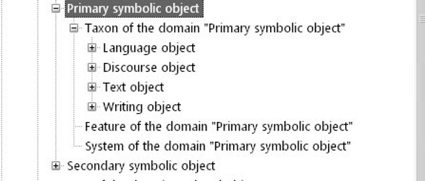
Here, it is more a question of an open-ended list than a veritable classification of more specialized domains of the world of language lato sensu, i.e. the world of systems of signs created by humans (and, in a more rudimentary manner, by other living species) to express, communicate, share, transmit, conserve and – of course – use values and knowledge about themselves, the world, and the Great Beyond.
The identification and elaboration of the taxonomic domains making up the term [Taxon of the domain “Primary symbolic object”] were – once again – dictated by the corpora of audiovisual texts we have worked with over recent years. However, the modular nature of the meta-lexicon, based on the central notion of taxonomic domain and its “basic” definition using “our” canonic triplet of conceptual terms, will facilitate the task of transforming that list into a more elaborate form of classification.
This transformation will, doubtless, have to take account of a more advanced reflection on the organization of the different systems of signs available to an agent to communicate about the facts around him.
Figure 13.13 shows the main taxonomic domains making up the world of symbolic systems which presuppose language lato sensu. For the time being, we distinguish three major taxonomic groups:
– the first group of taxonomic domains, transversal in nature (i.e. certain features of which are found, one way or another, in all the other taxonomic domains) is made up of the three domains which are organized around the terms [Object “Epistemic culture”], [Object “Axiological culture”] and [Object “Culture of transcendence”];
Figure 13.13. The three groups of taxonomic domains making up the branch [Secondary symbolic object]

– the second group includes the taxonomic domains which allow us to describe subjects relating to the knowledge, visions, ideas, rules, norms, etc. which fashion and/or respond to problems and interrogations stemming from the social world or from one of its specific fields (this is the case, for instance, of the taxonomic domains which serve to describe subjects relating to political culture, educational culture, economic culture, etc.);
– finally, the third group is made up of taxonomic domains which serve to describe subjects relating to what we call the arts and literature.
13.8. Taxonomic domains belonging to the branch [Primary symbolic object]
Let us now take a brief look at the taxonomic domains which illustrate the conceptual term [Primary symbolic object]. Of the four specific conceptual domains which form the ASW universe of discourse, the three domains [Language object], [Text object] and [Discourse object] are particularly important for our research into the analysis of audiovisual corpora:
– the domain [Language object] because it constitutes the domain of reference for a large number of audiovisual texts analyzed during the ASW-HSS project (often interviews and conferences with researchers devoted, for example, to one or more families of languages, to a particular language, linguistic structure, sociolinguistic phenomenon, etc.);
– the domains [Discourse object] and [Text object] because they refer to the internal context peculiar to any thematization of a knowledge object (such as a language or family of languages): the discourse as a “tool”, as a means for the author to speak and communicate about an object of reference; the text as a tool for recording the (author’s) discourse on a given support.
Figure 13.14. The taxonomic domain represented by the conceptual term [Discourse object]
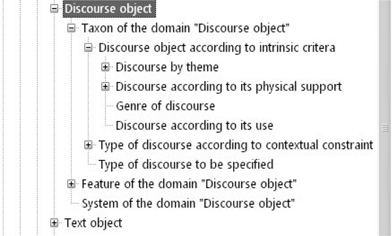
The taxonomic domain represented by the term [Discourse object], however, holds a particular importance for the approach developed herein of description and indexation of the content of a text, a corpus or even an entire audiovisual archive. It brings together the conceptual vocabulary we need in order to analyze, on the one hand, the type of discourse (descriptive, narrative, explicative, polemic, etc.) used by an author to “speak” about a given subject, and on the other hand, the discursive features of the thematization of a subject – features such as the purpose of a subject, the main theme (the thematic isotopy), the author’s point of view, the thematic hierarchization in the discourse, etc. In other words, here we find categorized that specific category of analytical objects which we have termed discursive objects (see Chapters 5 and 7).
Figure 13.14 shows an extract of the taxonomic domain which is organized around the basic conceptual term [Discourse object]. For the moment, we have primarily concentrated on identifying the main types of discourse and on a recurring set of discursive features which are needed for our particular analyses. That said, in structuring this taxonomic domain in the form of an elementary vocabulary of conceptual terms, we have drawn inspiration from research in rhetoric and discourse analysis (see e.g. [JAW 99; MAC 02; MAI 96]) and from different descriptive terminologies and ontologies devoted more particularly to the object “discourse”.
Figure 13.15. The taxonomic domain represented by the conceptual term [Text object]
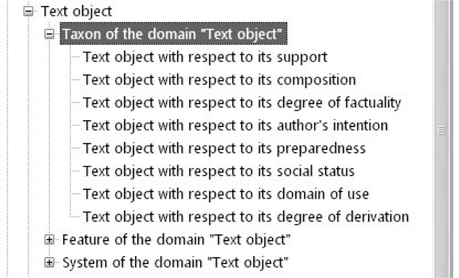
The second central taxonomic domain is, as mentioned above, that which is organized around the conceptual term [Text object]. Figure 13.15 shows an extract of its organization and the elementary vocabulary we currently use to give an account of the different objects in segmenting and describing the audiovisual text itself. As we saw in Chapter 2, the segmentation of an audiovisual text serves for locating and identifying the passages which are most pertinent in terms of the analyst’s objectives.
Description of the audiovisual text may relate to the text in its entirety (e.g. a recording of a conference, a documentary, etc.). It may only relate to a particular passage of the audiovisual text (e.g. one or more extracts from a conference, a sequence in a documentary, etc.). Finally, it may relate to a set of texts and/or textual passages making up an audiovisual corpus (e.g. extracts from a number of conferences and seminars devoted to a particular topic).
Figure 13.16. The conceptual domain represented by the conceptual term [Language object]

The recommendations of the Text Encoding Initiative (TEI)8 served as central references for us in elaborating this taxonomic domain, in that they proved pertinent for the analysis of a corpus of audiovisual texts. This is the case, for instance, with conceptual entities such as a unitary text or group of texts, body of the text and appendix to the text (e.g. in the context of filmed discussions following a conference or seminar session), cutting of the text into segments (paragraph, region) or indeed interpretation of the text (in the form of comments, belonging to specific kinds of commentary).
Finally, a few words on the subject of the taxonomic domain [Language object] (Figure 13.16) which is fairly frequently thematized in the corpus comprising the two experimental archives CCA and LHE. The main conceptual terms representing the taxonomic domain [Language object] were identified and defined, as far as possible, in reference to GOLD (the General Ontology for Linguistic Description)9, which is one of the seminal ontologies for linguistic analysis per se.
Only a small subset of the GOLD ontology is actually integrated into the current version of the ASW meta-lexicon. Indeed, it was not our objective to analyze languages and linguistic usages. Rather, the main objective was the analysis of subjects relating to linguistic work – subjects touched upon, for instance, in interviews, lectures and conferences filmed as part of the Audiovisual Research Archives (ARA) program.10 Such analysis does not go into the details of describing a language or a family of languages, nor of the concrete usages of a language by its speakers.
On the other hand, given that the main terms from GOLD have a clearly identified place in the taxonomic structure of the ASW meta-lexicon, it would not be an overly complex task to integrate the rest of this ontology so as to make it available to the analyses concerned.
In other words, the ASW Description workshop could perfectly well be used for a systematic and fine-grained description (i.e. which corresponds to the level of precision of GOLD) of linguistic audiovisual corpora: conversation analyses, lexicogrammatical analyses, phonetic analyses, etc.
13.9. Taxonomic domains belonging to the branch [Secondary symbolic object]
The taxonomic domain organized around the conceptual term [Secondary symbolic object] covers a whole series of more specialized taxonomic domains which enable us to analyze subjects relating to the beliefs and religions, scientific research, literature, music and visual arts, ideologies and political views, knowledge and technical knowhow or indeed the systems of values, the norms or rules governing, say, a social group, for example.
These are central empirical domains thematized in the audiovisual corpora upon which our analysis was based. As already explained above (see section 13.4 and Figure 13.13), the terms belonging to the vocabulary of the branch [Secondary symbolic object] are grouped into three main sets (see Figure 13.17), which form or could form more specific taxonomic domains.
Figure 13.17. The taxonomic domain whose root is the conceptual term [Object “Crossculture”]

Thus, a first group encompasses all the conceptual terms we need in order to describe knowledge objects relating to, for example, the beliefs, ideologies and thinking of a group, their values and norms, customs and traditions but also knowledge and knowhow – scientific knowledge and knowhow in particular.
A second group is made up by the set of terms we use to describe what is sometimes called social cultures, i.e. the reference frameworks (after Taylor [TAY 98]; also see [STO 11c]) defining the identities and specificities (cognitive, axiological, normative, etc.) of the different domains and sectors of social life such as, for example, those of education, health, politics, the economy, and so forth.
Finally, a third group of conceptual terms serves us to discuss the thematization of knowledge objects relating not to artistic or literary works, but rather to the reference frameworks, to artistic, literary or musical cultures.
Let us now take a brief look at some examples from the first and third groups; as the second group is currently present only in a rudimentary form, we prefer to discuss it later.
As Figure 13.17 shows, the first group of conceptual terms belonging to the major branch [Secondly symbolic object] brings together the taxonomic domains which are based on the terms [Object “Epistemic culture”], [Object “Axiological culture”] and [Object “Culture of transcendence”]:
Figure 13.18. The taxonomic domain whose root is the conceptual term [Object “Epistemic culture”]
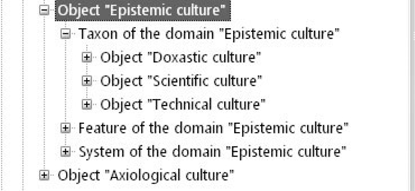
– the vocabulary which depends on the root conceptual term [Object “Epistemic culture”] facilitates the description of systems of knowledge comprising scientific (or otherwise), doxastic (i.e. defining the evidence and truths for a social actor) or indeed technical knowledge;
– the vocabulary which depends on the root conceptual term [Object “Axiological culture”], as the expression “axiology” suggests, serves for describing the values (be they collective or personal, general or specific to a practice, a social field, etc.) including, notably, the norms, rules (explicit or tacitly accepted) and other laws (juridical in the sense of contemporary law, pre-juridical, traditional, customary, sacred, etc.). A category of conceptual terms which is set somewhat apart (according to von Wright [VON 63]) but included in this vocabulary of conceptual terms is that which facilitates the description of so-called technical rules, i.e. instructions and procedures. Figure 13.18 shows the group which is organized around the three main taxonomic domains, [Object “Doxastic culture”], [Object “Scientific culture”] and [Object “Technical culture”];
– finally, the vocabulary which depends on the root conceptual term [Object “Culture of transcendence”] enables us to describe subjects devoted not only to religious systems and movements but also to so-called popular beliefs, to all forms of “spontaneous” beliefs of a group, or indeed to that category of heterodoxic beliefs which, depending on the case, we term “sect” beliefs, heresy, etc.
We can clearly see that the boundaries between these three domains of analysis are blurred. After all, a doxa naturally tends to establish itself as a norm for all those who believe in it (“believe” is used here in the sense of a fiduciary relation, a relation of trust said to be primary, spontaneous or non-reflected [GRE 79; RIC 83]) and who turn it into a dogma in the quasi-religious sense. These cognitive forms are indistinct in the sense that they almost-indissociably mix epistemological, axiological and fiduciary (belief) aspects. In order to get a handle on them, the analyst can describe them as secondary symbolic systems (without further specifying them in relation to such-and-such a more restricted conceptual domain).
Figure 13.19. The taxonomic domain whose root is the conceptual term [Object “Art culture”]
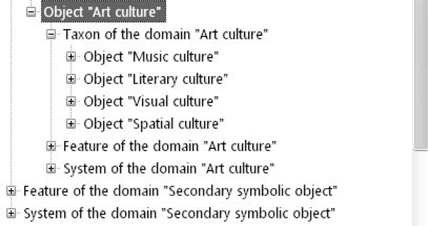
Let us now look at Figure 13.19. This shows an extract of the branch whose root term is [Object “Art culture”]. This term opens up the taxonomic domain of the third group identified above which, along with the group of transversal cultural objects and cultural objects from the social world, comprise the branch [Secondary symbolic object]. For the time being, within this third group, we have distinguished the more specific taxonomic domains composed of conceptual terms using which we can analyze audiovisual subjects devoted to musical, literary, visual and architectural cultures.
We are fully aware that for the moment, this is a simple list of taxonomic domains relating to the analysis of audiovisual subjects devoted to art and literature. The identification and elaboration of these domains correspond to the specificities of the audiovisual corpora on which we worked. Analyses of more varied audiovisual corpora will reveal the limits of this current organization and therefore the modifications which must be made to it.
13.10. The taxonomic domains of the branch [Object “Perdurant”]
The second major branch forming the canonic base of the ASW meta-lexicon which serves to define our objects of analysis is that which begins with the conceptual term [Object “Perdurant”]. As already explained in Chapter11 (section 11.3), this branch brings together all the conceptual vocabulary we need to describe subjects relating to the actions, activities, processes, changes or indeed to phenomena which – truly – perdure further over time, as is the case with situations, states or balances and imbalances.
Figure 13.20. The root of the branch beginning with the conceptual term [Object “Perdurant”] – a canonic term in the ASW meta-lexicon
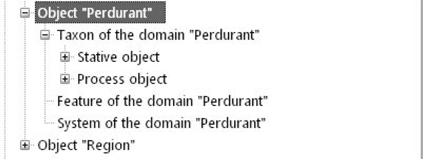
Figure 13.20 shows the two basic taxonomic domains which make up the branch [Object “Perdurant”]. These are the taxonomic domain initiated by the conceptual term [Stative object] on the one hand, and the taxonomic domain initiated by the conceptual term [Process object], on the other.
Figure 13.21. Taxonomic organization of the domain initiated by the conceptual term [Stative object]

Knowledge objects which can be represented and described by the conceptual vocabulary whose root term is [Stative object] are phenomena which are distinguished by a form of maintenance (qualitative or quantitative) over time. Figure 13.21 shows the three main taxonomic domains specifying the term [Stative object].
The first taxonomic domain is organized around the conceptual term [Object “State of being”]. Under this somewhat barbarous denomination, we find a small specialized conceptual vocabulary which we use to describe, for example, a psychic state or a social status (such as being a citizen or being a foreigner). More generally, here, it is therefore a question of describing subjects thematizing a relation of identity or of identification (the junction, to use Greimas’ term [GRE 79], between an agent (or object) and a quality, a feature, an attribute, or a feeling or sensation).
The conceptual term [Object “State of having”] initiates a second taxonomic domain specifying the branch [Stative object]. This typically concerns relations of economic possession or other forms of possession, e.g. relations of wealth or poverty – subjects that are massively developed in our audiovisual corpora on globalization and immigration.11
Finally, the third taxonomic domain specifying the root conceptual term [Stative object] contains a specialized vocabulary enabling so-called intersubjective situations to be analyzed, more particularly. For instance, these might be consensual situations (peace, entente), polemic situations (conflict, crisis, embargo), asymmetrical situations (domination, oppression) or denial situations, i.e. refusals (symbolic or physical exclusion and denial of the other).12
Figure 13.22. Taxonomic organization of the domain initiated by the conceptual term [Process object]
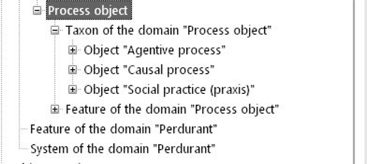
The second major branch which constitutes the canonic term [Object “Perdurant”] is initiated, as Figure 13.22 shows, by the conceptual term [Process object]. Once again, this branch is broken up into three more taxonomic domains which are more specific but are very unequally developed in the current incarnation of the ASW meta-lexicon.
Figure 13.23. Taxonomic organization of the domain initiated by the conceptual term [Process object]
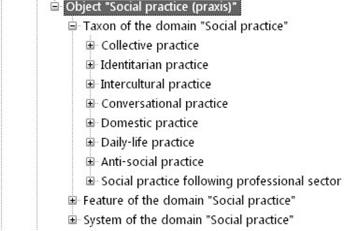
The first two of these taxonomic domains begin with the terms [Object “Agentive process”] and [Object “Causal object”]. Together, they enable us to distinguish between causal and intentional processes. This distinction, wellknown in lexicology, serves to identify physical or biological processes on the one hand, and on the other, activities whose originator – the “author” – is any agent who possesses a certain intentionality (i.e. capable of acting in a premeditated way to satisfy a need, a desire or any other motive for action).
Finally, the third taxonomic domain which specifies the conceptual term [Process object] is organized around the conceptual term [Object “Social practice” (praxis)]. This umbrella term covers individual or collective practices, professional or otherwise, which form complexes of activities carried out in a stereotyped manner, i.e. in the form of fairly predictable routines or rituals.
Figure 13.23 shows an extract from this third taxonomic domain which in fact plays an important role in describing the content of our audiovisual corpora. The conceptual vocabulary therein serves us to describe, for example, festivals, rituals, artistic and artisan practices, communication practices, educative practices, agricultural or industrial work patterns, and so on.
13.11. The taxonomic domains of the branch [Object “Region”]
Let us take another brief look at the taxonomic organization of the branch initiated by the third canonic conceptual term in the ASW meta-lexicon of conceptual terms denoting the analytical objects* which belong to the universe of discourse* of the ASW archives – the canonic conceptual term [Object “Region”].
As Figure 13.24 shows, we distinguish two main taxonomic domains here: the first is initiated by the conceptual term [Object “Spatial region”], the second by the conceptual term [Object “Temporal region”].
The branch beginning with the conceptual term [Object “Spatial region”] is divided, as Figure 13.25 shows, into a series of taxonomic domains which have yet to be put into a better structure. For the time being, we find specialized conceptual vocabularies which are highly useful for the descriptive activity whose objective is to locate the knowledge objects thematized in an audiovisual text or corpus, within time and space.
Figure 13.24. General organization of the branch beginning with the canonic conceptual term [Object “Region”]

For instance, we find here the conceptual vocabulary we need in order to identify and describe a geopolitical region, workplace, urban or rural space, etc.
Figure 13.25. The taxonomic domains currently identified which specify the conceptual term [Object “Spatial region”]
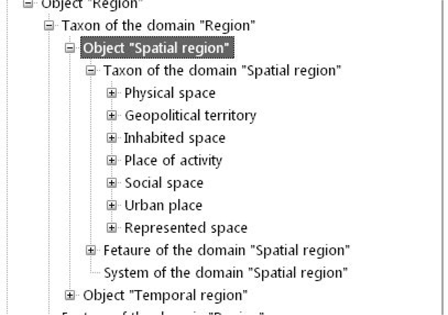
Finally, Figure 13.26 shows the current taxonomic organization of the branch initiated by the conceptual term [Object “Temporal region”]. For now, provisionally, we distinguish between two main groups of taxonomic domains.
The first group is reserved for defining the conceptual vocabulary we need in order to identify and describe basic temporal objects with or without durations such as, for example, instants and (temporal) periods or, in more concrete terms, temporal units such as days, months, years, decades and centuries.
Figure 13.26. The taxonomic domains currently identified which specify the conceptual term [Object “Temporal region”]
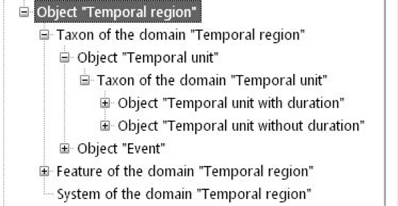
The second group is reserved for describing events: events which punctuate biological or social life (birth, moments of passage, death), historical evolution, personal or collective identity or indeed reverence of and union with a transcendent being.
1 Let us note in passing that the term object of value merely expresses the fact that the object plays a certain role for the subject-observer, possesses a certain function for an agent who has intentional capacity. Of course, a material object does not necessarily become an object of value by virtue of its rarity or high price: in its function as a construction material, the most ordinary of stones is probably an object of more appreciable value than the Blue Diamond of the Crown of France (also known as the French Blue).
2 As regards the triplet [Taxon of the domain of value], [Feature of the domain of value] and [System of objects of value], see section 13.3.
3 As regards the expression “taxonomic domain of knowledge”, see section 13.3.
4 See http://databases.unesco.org/thesfr/.
5 As Bruno Bachimont correctly explains [BAC 05], not everything is in the text; we therefore have to find and use other sources of information to construct a conceptual metalexicon which “holds water”… Thus, a whole series of thesauruses, terminologies, glossaries and other vocabularies have been useful when constructing the current edification of the conceptual vocabulary making up the taxonomic domain headed by the conceptual term [Functional material object]. As a mere example, let us cite the AAT (Art & Architecture Thesaurus) from the Getty Research Institute (http://www.getty.edu/research/tools/vocabularies/), the Materials Thesaurus from the British Museum (http://www.collectionslink.org.uk/assets/ thesaurus_bmm/matintro.htm), the PACTOLS thesaurus from the Centre Camille Jullien at the CNRS (http://biaa.univ-provence.fr/ListRecord.htm?list=table&table=5), the thesaurus of designations of architectural and building works from the Architecture and Heritage Council at the (French) Ministry for Culture and Communication (http://www.culture.gouv.fr/culture/inventai/ patrimoine/), etc.
6 See http://www.culture.gouv.fr/culture/inventai/patrimoine/.
7 Remember that these are the corpora making up the three experimentation workshops of the ASW-HSS project: the CCA archives, the LHE archives and the ArkWork archives.
8 For further information relating to electronic encoding of texts using the TEI, see http://www.tei-c.org/Guidelines/Customization/Lite/teiu5_en.html.
9 See http://linguistics-ontology.org/version.
10 URL of the portal: http://www.archivesaudiovisuelles.fr/FR/.
11 In particular, see the audiovisual collection of the FMSH-ARA archives: http://semiolive.ext.msh-paris.fr/fmsh-aar/.
12 Once again, these subjects are abundantly present in the audiovisual collection of the FMSH-ARA archives: http://semiolive.ext.msh-paris.fr/fmsh-aar/.
![Chapter 13: Detailed Presentation of the Conceptual Vocabulary [Object of analysis]](https://imgdetail.ebookreading.net/cover/cover/data/EB9781118614099.jpg)